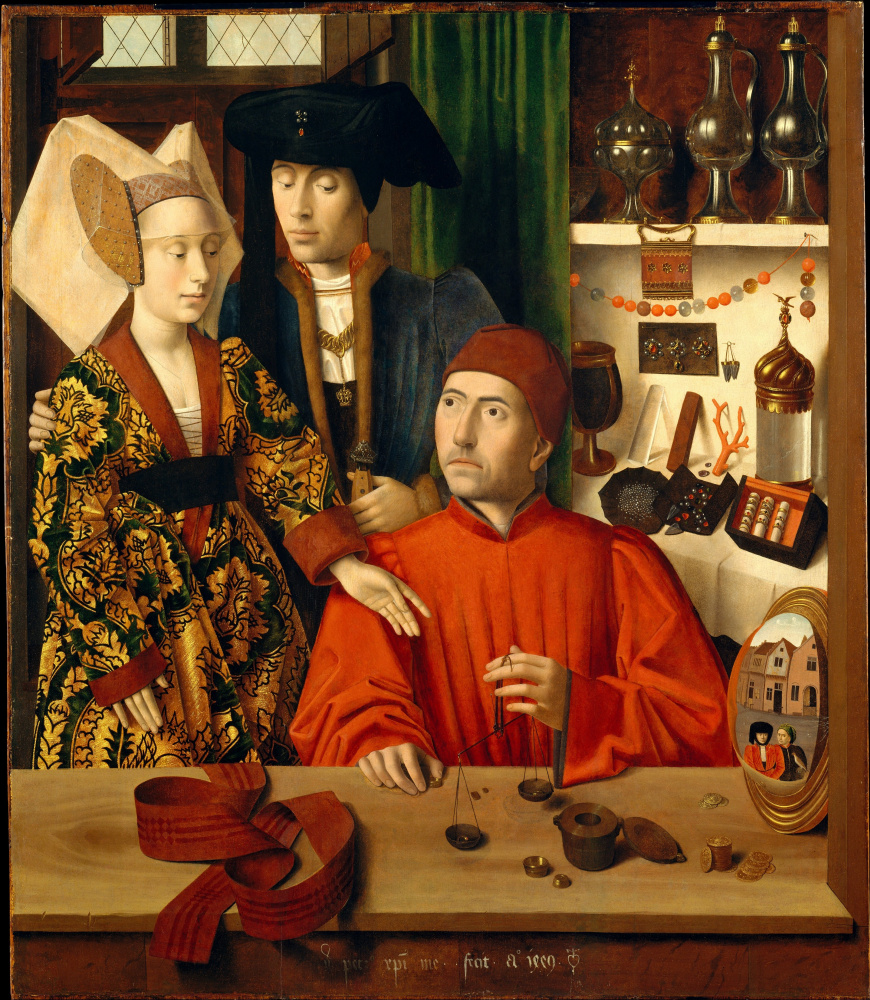log in
Enter site
Login to use Arthive functionality to the maximum
A Goldsmith in his Shop (Saint Eligius)
Petrus Christus • Painting, 1449, 100.1×85.8 cm
Description of the artwork «A Goldsmith in his Shop (Saint Eligius)»
Among Christus's best known works, A Goldsmith in his Shop, signed and dated 1449, is also perhaps his most enigmatic. This view into a goldsmith's stall, where a fashionably dressed couple chooses a wedding ring, conveys a sense of the opulent world of 15th-century burghers.
The goldsmith was once identified as Saint Eligius, who brought Christianity to Flanders and was associated in Bruges with the guilds of the gold- and silversmiths, the blacksmiths and metalworkers, and (along with Saint Luke) the painters and saddle makers. Still, it is more likely a vocational painting, depicting the profession of goldsmithing and perhaps a particular goldsmith.
Technical analysis reveals the underdrawing of the goldsmith's face to be very fully modelled – more so than the faces of the bridal couple – suggesting the possibility of a portrait. The art historian Hugo van der Velden suggested that Christus portrayed Willem van Vleuten, a Bruges goldsmith who worked for Philip the Good, duke of Burgundy. In 1449, the date of this painting, the duke commissioned from van Vlueten a gift for Mary of Guelders for her marriage to James II, King of Scots. That couple may well be depicted in this painting.
The diversity of finely crafted objects at the right serves as a kind of advertisement for the goldsmiths’ guild. Included are raw material of the trade – coral, crystal, porphyry, open sacks of seed pearls, and a string of beads – and finished products made from them – brooches, rings, and a belt buckle. The crystal container on the lower shelf was probably meant for storing Eucharistic wafers, and the pewter vessels above are presentkannen, or donation pitchers, which the city’s aldermen offered to distinguished guests. The assemblage of objects thus presents gold- and silversmiths in the service of both religious and secular communities.
The Eyckian device of the convex mirror reflects two young men with a falcon, symbolising pride and greed. Thus Christus establishes a moral comparison between the imperfect world of the viewer and the world of virtue and balance of the protagonists.
Author: Vlad Maslov
The goldsmith was once identified as Saint Eligius, who brought Christianity to Flanders and was associated in Bruges with the guilds of the gold- and silversmiths, the blacksmiths and metalworkers, and (along with Saint Luke) the painters and saddle makers. Still, it is more likely a vocational painting, depicting the profession of goldsmithing and perhaps a particular goldsmith.
Technical analysis reveals the underdrawing of the goldsmith's face to be very fully modelled – more so than the faces of the bridal couple – suggesting the possibility of a portrait. The art historian Hugo van der Velden suggested that Christus portrayed Willem van Vleuten, a Bruges goldsmith who worked for Philip the Good, duke of Burgundy. In 1449, the date of this painting, the duke commissioned from van Vlueten a gift for Mary of Guelders for her marriage to James II, King of Scots. That couple may well be depicted in this painting.
The diversity of finely crafted objects at the right serves as a kind of advertisement for the goldsmiths’ guild. Included are raw material of the trade – coral, crystal, porphyry, open sacks of seed pearls, and a string of beads – and finished products made from them – brooches, rings, and a belt buckle. The crystal container on the lower shelf was probably meant for storing Eucharistic wafers, and the pewter vessels above are presentkannen, or donation pitchers, which the city’s aldermen offered to distinguished guests. The assemblage of objects thus presents gold- and silversmiths in the service of both religious and secular communities.
The Eyckian device of the convex mirror reflects two young men with a falcon, symbolising pride and greed. Thus Christus establishes a moral comparison between the imperfect world of the viewer and the world of virtue and balance of the protagonists.
Author: Vlad Maslov


